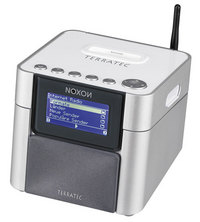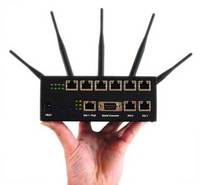Category: Wi-Fi
TerraTec launches Noxon 2 internet radio/iPod dock
 Around six months after it launched the Noxon net radio, TerraTec has announced the Noxon 2, which adds iPod functionality and a little bit more to the mix.
Around six months after it launched the Noxon net radio, TerraTec has announced the Noxon 2, which adds iPod functionality and a little bit more to the mix.
D-Link launches DKT-410 Wireless N starter kit
Looking top upgrade your networking hardware? D-Link might have the thing with the DKT-410 Wireless N starter kit. The DKT-410 kit includes the DIR-635 wireless N router and a DWA-140 wireless N USB 2.0 adaptor. That should boost your…
Dell happy with pre-standard 802.11n Wi-Fi equipment
 Dell has defended its decision to join the growing number of manufacturers releasing high-speed Wi-Fi equipment based on the draft 802.11n specification.
Dell has defended its decision to join the growing number of manufacturers releasing high-speed Wi-Fi equipment based on the draft 802.11n specification.
Given the amount of gadgetry already on the market you’d be forgiven for thinking the standard was near completion, but in fact it isn’t due to be ratified until March 2009.
Liam Quinn, Dell’s chief technology officer for communications, security, peripherals and systems, told ZDNet that it doesn’t really matter that the standard hasn’t been finalised yet.
Daily Tech Hotlinks for 31-May-07: Tiscali, Firefox, Wi-Fi, iTunes

– Tiscali has admitted it will take at least 10 days to restore their customers’ email addresses to full functionality, after being blacklisted as spam by various ISPs. At least we’ve got Big Brother now to distract us…
– Web browser junkies will be jonesing for the fifth alpha release of Firefox 3 from Mozilla set for release tomorrow, sadly syringes aren’t included.
– Apparently Londoners aren’t interested in free internet and the plethora of potential Bittorrents possible, as only 6,000 people have registered to use the free City of London…
The Slurpr: WiFi aggregator
The idea behind the Slurpr is that it can grab open networks with its six wireless interfaces and aggregates them into one huge broadband connection. The inventor of this little doohickey, Dutch hacker Mark Hoekstra, is now working on an upgrade that will allow the user to aggregate closed networks as well. (Legality of that subject to inquiry.) You can pre-order the Slurpr for a thousand Euros, and then everyone can link all their Slurprs and it will eat the world. [GT]
Slurpr- the mother of all wardrive boxes [via Gadget Lab-Wired Blogs]
BBC cops more flak for Panorama Wi-Fi documentary
The fallout is continuing over last week’s BBC Panorama programme about Wi-Fi radiation. Ben Goldacre, who writes the Guardian’s Bad Science column, laid into the Beeb this weekend over the way it measured Wi-Fi radiation in the show.
Hitachi RFID chips sleeps on the Singapore fishes
Keeping track of what fish is which can be difficult when there’s only a few of them, and when you’ve got a whole aquarium featuring hundreds of identical swimmers it can be close to an idiot savant talent. Underwaterworld Singapore has streamlined the process by using Hitachi RFID dust to tag individual fish with a lightweight payload that lets aquarium visitors easily tell an arapaima from a pacu. When the fish swims past a sensor, the name of the fish is displayed. The system cost a little under £10,000 to set in place and will be extended soon to include their shark population. [GT]




















